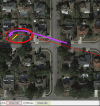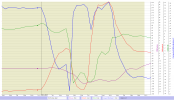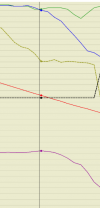Sorry ... but this incident will fall into the category "
Mavic 3 oddities" unfortunately. In order to maybe find a possible cause either of the 2 DAT logs would have been needed ... but they are encrypted & can't be read by us.
The TXT log mainly confirms your story of an uncommanded CCW rotation of approx 63 degrees at about 232sec into the flight. The winds were moderate & came from a northerly direction.
Have red-circled where it happens ... the purple hand drawn arrow is what the charts further below cover.
View attachment 142080
Have placed the chart marker where the yaw (purple) starts to go in a CCW direction ... at the time you had a full throttle for descent (dashed greenish) & had just stopped to ease off the forward stick command (dashed yellow)(stick commands have value 1024 as neutral) ... both the heading speed (blue) & the vertical descend speed (green) were still nearly on max... no rudder input was made (dashed black)
(Click on all charts below to make them larger)
View attachment 142081
Below I have added pitch (red) + roll (green) ... & also the total tilt angle (dashed blue) which is a combination of pitch & roll.
The chart marker is again where the uncommanded yaw movement starts ... where you still have the throttle for max descent, but just make a pause in easing off the forward stick command.
We see that the craft make big tilt changes not motivated by your stick inputs ... or the moderate wind. The pitch angle goes rapidly from 32 degrees to 0 degrees & the roll goes from leaning into the wind with the crafts right side with about 14 degrees ... to easing off to approx. 9 degrees. The dashed blue tilt shows a craft mid the uncommanded turn that is nearly leveled with only a couple degrees tilt, but still with a heading speed of nearly 40mph & a vertical descend speed around 13mph... so mainly like a frisbee in the air.
View attachment 142083
So ... in the end we see what happens & that it's uncommanded, but we have to little data to say anything about a possible cause.














